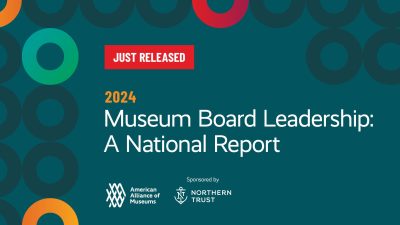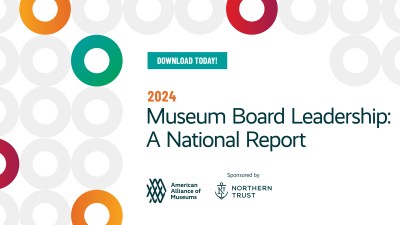
Kaywin Feldman is the Duncan and Nivin MacMillan Director and President of the Minneapolis Institute of Art (Mia) since 2008. She also serves on the boards of National Arts Strategies, the Chipstone Foundation, and the American Alliance of Museums (AAM). She is a past president of the Association of Art Museum Directors, and a past chair of AAM. You can find Kaywin on Twitter @kaywinfeldman.
I turned 50 this summer and my father passed away last year. Both events led me to do a lot of thinking about who I am, where I came from, and what I want to leave behind (commonly referred to as a mid-life crisis). At around the same moment AAM generously invited me to take 10 minutes at the annual meeting to talk about any subject I wanted to address. So I spoke about gender bias from a personal perspective. A friend said to me, “someone offered you the bully pulpit and you took it.”
I am at a point in my career where I can speak about the subject of gender bias, and have plenty of experience to share. After 23 years as a museum director, it is gratifying to have the platform to speak out, coupled with a secure position. I knew when I was told at the start of my career that I was “too young and too female for a curator to report” to me that I had to keep quiet and move on; I had too much to lose and not much to gain by speaking out at that time.
I think a lot — and worry a lot — about our field becoming almost entirely female. We are a stronger, healthier, and more relevant profession the more diverse we are in every possible way. And, as noted in my speech given at the 2016 AAM Annual Meeting, when professions become mostly female, they become less well respected and more poorly paid. After all, if so many women can do the job, how hard can it really be? I am very worried about this gradual change and to be honest, not sure what to do about it. I hope that others will join me in grappling with this issue before it just happens and we have to claw our way back.
Watch Kaywin’s powerful speech in the video below where she discusses her experiences and observations as a female museum director. How can museums develop a culture that better values diverse leadership styles? If we did, how would this change the field? The following video was recorded May 27th at the American Alliance of Museum’s 2016 Annual Meeting in Washington, D.C.
Video Transcript
As I conclude my own two-year term as the Alliance’s board chair, I want to share a few observations that are very important to me, both personally and professionally.
I became a museum director at the age of 28. After I had been in the job for about 3 years, I interviewed for a slightly larger museum in Texas. During the meeting, the chair said to me “You are far too young and far too female for a curator to report to you.” And just to ensure that I remain mad about it, a few years ago I related the story to the then-director of this Texas museum, who was a strapping 63-year old former football player. Even though I had been the director of 2 larger art museums for the last 12 years when I spoke with him, he said, “Good advice, it is true.”
I would like to speak to you for a few minutes today about power, influence, and responsibility from a personal perspective. And I’m definitely going to play the woman card.
I have encountered “far too young and far too female” for most of my 22-year career as a museum director.
I have to say first off that I am so very grateful to the 3 museum boards that have hired me as their director. These boards bucked a trend in hiring me and giving me a chance. I love my job and feel so fortunate to have had such a rewarding career.
I’ve done a fair amount of interviewing to get to where I am. I heard the exact same concern every time I was not hired – and even when I was hired – “We are worried that she doesn’t have gravitas”.
I’d like to unpack gravitas for a moment. It was one of the key Roman virtues, along with pietas, dignitas, and virtus (which, incidentally, comes from “vir”,the Latin word for man).
Gravitas signifies heft, seriousness, solemnity, and dignity. It is weighty and replete with importance. I have come to realize that it is also subconscious code for “male”.
In fact, the dictionary gives the following two examples of “gravitas” in a sentence:
- a post for which he has the expertise and the gravitas
- A comic actress who lacks the gravitas for dramatic roles.
Funny that – the negative example of gravitas is female. The Urban dictionary defines the word as “a part of the male anatomy”, going on to say for example, that the few female news anchors who are thought to possess gravitas are often assumed to be lesbians or described as shrill and therefore do not last long in their positions. Instead, American news anchorwomen are often offered “perky” as a substitute description.
Please understand that my beef isn’t with the word gravitas itself, it is with the cowardly discrimination that hides behind the use of the word. It’s this thinking:
- Women don’t have gravitas
- Leaders must have gravitas
- Women can’t be leaders
We recently completed a branding process at the Minneapolis Institute of Art, working with the design firm Pentagram. We had been in the fun and engaging process of fully defining and expressing our brand for the previous 4 years. Pentagram studied us and responded, “Your full name is too long. Luckily, your acronym is pronounceable. You’re just saying your name wrong. Instead of being MIA – Missing in Action or the Miami International Airport – you should be “Mia”, which means “mine”, “my own”, or “beloved” in 8 languages. Now that was pretty compelling, but our team was concerned. At first nobody articulated it, but the discomfort derived from Mia being a female name. Finally, one of our trustees voiced it: he didn’t like Mia because “it is not strong. It’s not classical or smart. It’s just not serious.” I pointed out that if our name spelled “SAM” or “STEW” he wouldn’t have had the same reaction. What he was clearly saying, was that the name – a female name – didn’t have “gravitas”.
A recent New York Times article noted that when a profession that is largely male transitions to largely female, salaries go down significantly, even after adjusting for education, experience, and geography. The implication is that the job just can’t be as serious, challenging, or sophisticated if it can be done by women.
When I read it, I realized that this was one of the main reasons many boards are reluctant to hire women directors. Deep down, they fear that it would demean and debase their museum – and the profession – if a woman can do it.
In the art museum field, about 45% of museum directors are female. That’s great. But among the 17 largest encyclopedic art museums, with budgets over $30 million, there are only two of us. A colleague noted that the Association of Art Museum Directors is replete with foreign accents, noting that art museums are now importing men from abroad.
I promise you that boards don’t explicitly decide that they want to hire a man; I know they have the best of intentions and are committed to diversity. But they think a director has to exude silver haired baritone solemnity, and therefore they unwittingly rule out female applicants. This sort of underlying sexism is so much more insidious even than the trustee who once said directly to me “things would go a lot better if you would do as you’re told”.
Again, I am deeply grateful for all of the opportunity that I have had in my career, however hard I had to fight for it. I’m one of the lucky ones. Of course, I believe that leadership qualities are equally found in women as in men, even if they can look and sound a bit different. I feel the responsibility, however, to call it out, and I urge all of you to use your influence to make sure that our society’s power structures no longer hide behind implicit discrimination and bias.
One last story. When I first started at Mia, we had a Nazi-era Holocaust claim that was 11 years old. It was a complicated case and it had taken us a number of years to confirm that the painting on our wall was indeed the one looted. After that, the museum thought the heirs might have been compensated at some point because the picture had never disappeared from prominent public view. I came to the conclusion that we had never found proof of compensation, and that it was time to resolve the claim and return the picture to the heirs.
I felt miserable about the decision because our whole trustee committee was male, our lawyers were male, the curator was male, and my 2 predecessors who worked on the matter are male. The approach communicated to me was “We are going to win! We are going to fight this by not flinching.” Lots of chest pounding. I too felt pressured to “fight it”, as all of the men had been doing for 11 years. In returning the work, I was scared of the message – you hire a woman and what does she do in her first 8 months but compromise and give up? Where’s the stamina?
I called an all staff meeting so that I could personally tell the staff that we would be returning the painting and I felt as though I had failed each one of them – after all, protecting the collection is the most basic job of a director. It was hard for me to stand before them and let them know I was giving up a painting. I’m glad to tell you that the staff immediately joined together in a standing ovation, reassuring me that I had indeed done the right thing. And I did it with all of the seriousness, solemnity, and gravitas that are called for when righting the wrongs of a despicable Nazi-era crime.
And now, sticking with the theme of restoring looted artwork to its rightful owners, I have the honor of introducing our keynote speaker, an author whose work reminds us that monuments and other cultural treasures are important to society; and their survival depends on all of us.
Robert Edsel is recognized as one of the world’s foremost advocates for art preservation and the recovery of cultural treasures missing since World War II. The last twelve years of his life have been dedicated to the meticulous research of the Monuments Men and women, the soldier-scholars who helped save so many of the world’s great art and cultural treasures from the destruction of war and theft by the Nazis.
Mr. Edsel is the #1 New York Times best-selling author of three non-fiction books, Rescuing Da Vinci, The Monuments Men, and Saving Italy. Academy Award recipient George Clooney wrote, directed and starred in a film based on Edsel’s second book, The Monuments Men. And by the way, Mr. Edsel is making himself available to meet you at the Alliance bookstore in the MuseumExpo immediately following his keynote presentation.
Mr. Edsel is the Founder and Chairman of the nonprofit organization, Monuments Men Foundation for the Preservation of Art, recipient of the National Humanities Medal, our nation’s highest honor for work in the humanities field, which was presented by President Bush at the White House in 2007. Additionally, he serves as a Trustee at the National World War II Museum.
I want to recognize the World War II Museum for their support in making it possible for Mr. Edsel to speak to us today.
After years of advocacy to see the Monuments Men honored, Mr. Edsel participated alongside Speaker of the House John Boehner and Minority Leader Nancy Pelosi in the 2015 presentation to them of the Congressional Gold Medal, our nation’s highest civilian award.
Please join me in welcoming our keynote speaker, Robert Edsel.








I have spent my entire career working in museums; 47 years. A man in this profession faces those same sort of issues. As a CEO, I was always asked if I also had a “serious job,” or if I were “still in school,” suggesting that a museum profession couldn’t be that important. I always told those people, instead, that I loved coming to work! I have no ideas how to turn this country’s perspective around, except to recruit good people, keep their interest with good management and know that you will always love coming to work instead of having the weekend cabin. I’ve had a number of interns and student workers who realized that museum work was fun, who have then made museums their careers as well.
Timothy, we all have our own perspectives and challenges, but I would respectfully say these aren’t the same issues. It’s one thing for someone to denigrate or misunderstand your occupation in a social setting, it’s another for a hiring authority to doubt your ability to handle a leadership position because you’re female.
Perhaps part of the problem is how hiring is done. If there was more diversity in the search committee, there might be more diversity in the final candidates.
This was an inspiring speech describing a very real problem that resonates with many in the field.
I do wonder, however, if it’s possible to unpack the “young” from the “female”. The latter discrimination is deplorable; the former, however, is more complicated, especially in the museum world. I think it would be quite unusual for a person to rise to the level of director with only a few years of work experience after college (i.e. 28 years old). Curators, on the other hand, are often in their 40s at the Assistant Curator level, have spent decades in graduate school to earn a PhD (generally) and years publishing and working at their craft. It would indeed be unusual and difficult for such an experienced scholar to “report” to someone in their late 20s, early 30s, in my opinion.
So how do we unpack the sexism from the traditional hierarchy of achievement and ‘years in’? Maybe it’s not possible, but the older I get, and the more experience I have to offer, the more resentment I feel when a organization hires someone 20 years my junior, at, no doubt, 50% of my expected salary, and calls them a “wunderkind.”
I’m female by the way. Probably sour grapes.
Very valuable and frank account from Kaywin Feldman, and I too share many of her concerns. A challenge in dealing with these issues at the management/board level is the lack of something more concrete upon which to base dialogue and decision making: there can be way too much “attitude”, and not enough reliance on technical skill and evidence. The Nazi repatriation anecdote is very useful in this context. Once Feldman was satisfied there was no actual proof of compensation, the opposition seems to have collapsed.
Hello,
I work for global project, Statues For Equality to erect more female statues across the globe. We would love to partner with you and I was wondering if you would please be able to direct me to the best person?
Thank you!